
|
Note ye ed's email address: stevebryant99@gmail.com. |


It's here!
|
In last month's April issue a youngster is introduced to magic, Milt Larsen is on stage in 1937, Marc Summers stars in a bio play, Irene has a nice sendoff, MAGIC honors Paul Daniels, and we post a letter from Bill Larsen. |
May 2016 First, a happy, happy birthday to Harry Lorayne on his ninetieth! Steve Cohen and Harry's accountant put together a birthday bash with 100 magicians attending that you can view pix of here. Harry's latest book (reviewed in November) is still great and is the work of a young man. Just amazing. This month, we welcome back Karl Fulves who sends a package of four new magazines with props, we get our hands on Gene Anderson's new book, and we shiver at a spooky lecture download from Eugene Burger. Finally, my publisher, Month9Books, released my next novel cover on April 28, for McGrave's Hotel. See it below. Want to spend a night in a spooky hotel? The reservation lines are open. |
|
|
HE'S BAAAAACK! -- In January I posted a list of product wishes for 2016. To my surprise, the postman granted one of those wishes on May 11 with a fat package from Karl Fulves. Karl's long-awaited next project is a new periodical titled The Lowdown that will run for ten issues alternating with ten supplements on a variety of subjects. The initial package included Issue number 1 of The Lowdown (32 pp), of Errata (36 pp), of Early Indications (10 pp), and of Folderol (10 pp). Roughly, The Lowdown contains material such as ran in Prolix, The Pallbearers Review, and so on. Errata contains, among other things, reprints of hard to find Fulves material that relates to the new ideas in The Lowdown. Early Indications contains, among biographical musings, material that Karl worked on from age 5 to 20. And Folderol contains tricks with paper (Issue 1 discusses tricks with Flexagons). Props for the material are included as well, namely four relevant decks of cards, a set of short cards, and some Flexagon paper. 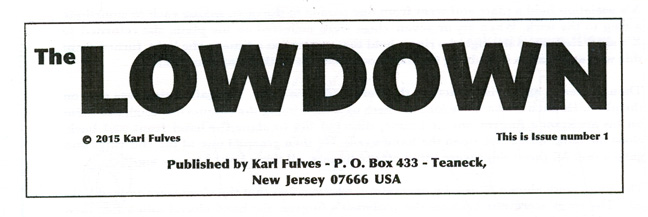 Karl's latest. It is a pleasure to sink into Karl's clear, concise, familiar prose, as distinctive as Harry Lorayne's. It also amazes me that, after decades of publishing, Karl still has a store of incredible, novel, satisfying material. I regret that I no longer have access to my Magic Monday crowd, a gang of engineers and magic enthusiasts, along with their eager children. They would have loved this stuff. A few standouts: Linking Finger Rings -- A Himber-less approach that would have fooled me (I'd have suspected a stooge). Club Double -- From ten cards in a row, you divine a spectator's card and he finds yours. A fiendish use of memory work and upside down writing make this possible. A useful memory scheme accompanies this item. Parallel Worlds -- A sort of double duke OOTW. Two amazing coincidences occur, one with the backs, one with the faces. Name Game -- Thanks to some cue cards, any poker hand called for is selected and then dealt; the hand appears at the designated spot, and you also deal a strong hand to a mark at another designated spot. No skill; it just happens. According to Hoyle -- In a five-handed game of five card stud, suspicious players insist that one, then two, then three, then four cards be swapped from the dealer's hand. He wins nonetheless. Sven Master -- Maybe the killer trick of the package. You name a card, spek names a card. You then name a number, spek names a number. Your cards appear at each other's number. Daylight Poker -- Spek selects any face-up poker hand. You select one as well. You take one card of the spek's hand for yourself, he takes one of yours. You win. Bio -- I'm not sure what to call it, but the bio info and scams were fascinating, especially Karl's past as a chess player and a bowling pinsetter. And much more along these lines. The Lowdown #2 promises a Scarne signed card to pocket trick, a novel take on estimation, and more games you can't lose. By the way, I have no idea if Karl Fulves wants new subscribers at this point. As it has been for decades, the only way to communicate with him is to write him, enclosing an SASE, at P.O. Box 433, Teaneck NJ 07666. |
|
|
TABLOID TRICKERY AND MORE -- As I mentioned in my review of last summer's history convention in Marshall, Michigan, Gene Anderson brought his A game. He always does, of course, with one of the great theme acts in magic. Gene is to newspapers what Marvyn Roy is to light bulbs. Gene also brought to that convention, as he has to other conventions for nearly ten years, galleys of his book-in-progress that has finally become, in a gorgeous 256-page hardback, Gene Anderson The Book. It's been a delight to have watched this book develop, even as the world (especially newspaper sizes and formats) changed around the author. (Gene laughed at, but declined, my suggestion for a title: Bottom of the Bird Cage.) For one thing, although there is plenty of painstakingly taught, groundbreaking material on newspapers, there is also much more to the book. Among this wealth of parlor material (a book of parlor magic is in itself a wonder), even the three card tricks are killer standup routines (the Nemo Jumbo Rising Cards, Harbin's Card in the Bottle, and a multi-phase Si Stebbins Card Routine). Gene has intentionally limited the items to his longtime professional repertoire, and this allows him unprecedented attention to detail. It isn't enough to mention that thread makes the Nemo Rising Cards work. Rather, he fills the chapter with thread choices and instruction on how to make the thread invisible. Only Gene, with his PhD in chemistry, could blithely discuss the chemical advantages of the best rubber cement for Clippo. Who else would know where to find free Tyvec to strengthen your paper hat? You'll find, in addition to newspaper tricks and parlor card tricks, work on rope, string, thread, paper chains, a vanishing lit match, the Die Box, the Egg Bag, tables of all sorts, and, the darling of the reviews I have seen so far: Picto Transpo. In that effect, a drawing you make of a spectator transposes with one she makes of you. There is room in this for hilarious audience interaction. 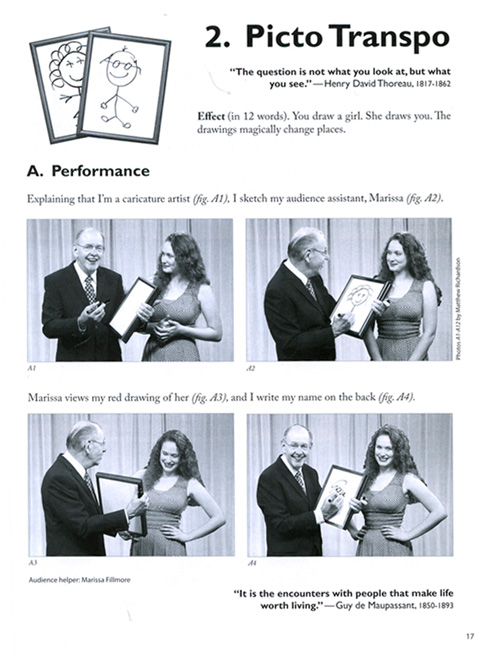 The book is beautifully laid out. But let's get back to newspapers. Here are the elements of Gene's iconic magic show, including "Amputated Origami" (Origami with one cut), Squircle, newspaper Chapeaugraphy, the Corn Stalk, the HELLO trick, and of course the Torn and Restored Newspaper. It's all there -- the history , the construction notes, the performance instructions, the patter, and the extra knowledge that comes only from decades of experience. The Paper Tree or Corn Stalk was in one of my first magic books, attributed to Jarrow's show, but I had no idea how to make one like Gene's, some fourteen feet tall. Size matters! 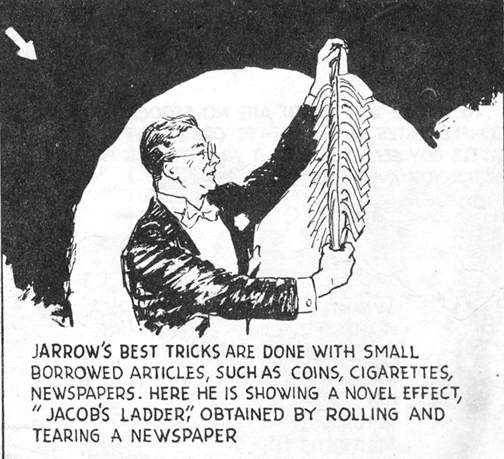 Jarrow would be hard-pressed to follow Gene's version. The book concludes, as does Gene's act, with the Torn and Restored Newspaper. Although there are several good methods out there, Gene's has been the go-to method for most professionals for nearly fifty years. You can trust it! I fondly recall Doug Henning performing it not only on his live show but on a Macy's Parade day broadcast on NBC. His regard for this method has become part of twentieth-century magic lore. A highlight of the book is the chapter on The Part-Time Pro. Every detail you need is there, down to the performance agreement and even how to develop new material. I commend Gene in this chapter for departing from the current dogma that you must have a strong character first and only then add tricks that the character allows. Gene's act development is trick selection first (with appropriate advice on how to do that), still, I suspect, how most magicians go about it. It's an approach one might expect from a magician whose reputation rests on a theme act. In real life, the tricks inform the character and the character eventually informs the tricks. The design of the book is stellar. Twenty-three of the twenty-eight chapters detail a single trick, complete with patter keyed to the action, and each chapter is stand-alone: you can read the book in any order. I laugh to think that some avoided Erdnase because it was "like geometry." Much of this book, especially the newspaper work, is geometry. Gene had to master Adobe Illustrator to bring all the folding and construction details to life. He further mastered Adobe InDesign to lay it all out. In addition to the considerable instructions, patter, and philosophy from Gene, the book is liberally sprinkled with wise and relevant quotations and with great snippets about Gene called "The Gene Pool." One of Gene's own lines that is sure to become a quotation in books by others, regarding "improvements": If it were better, would it be better? All in all: 28 chapters, 256 pages, 487 illustrations, 403 photographs, 206 quotes, 26 Gene Pool items, 1 hilarious limerick, 1 Mac King Foreword, and 1 Gene Anderson Introduction. 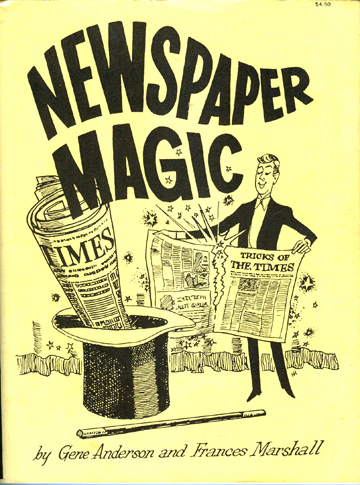 Gene's first book on newspaper magic. Reading Gene's new book inspired me to walk downstairs to the vault and take another look at his first major tome, 1968's Newspaper Magic, by Gene and Frances Marshall. It's still great and constituted my first intro to Gene's sense of humor. Indeed, I get far more of the jokes now that I am older! That collaboration led to Gene's Chicago lecture for IBM Ring 43, to which he brought sixty pre-folded papers. There, with newspaper Admiral hats on their heads, sat Werner "Dorny" Dornfield, Jack Gwynne, George Johnstone, Jay Marshall, Jack Pyle, and John Shirley, among others. Only in magic! Both books highly recommended. Gene Anderson The Book is available from geneanderson.com, $65 plus postage. Awesome! |
|
|
DARK SECRETS -- In 1986 Eugene Burger's Spirit Theater immediately established itself as the best book ever on spooky magic (still is) and Eugene himself as the leading authority on dark side magic. I crave any opportunity to hear Eugene expound upon the subject and thus happily tuned into his new Eugene Burger LIVE 2 lecture from Penguin Magic (premiered May 15). 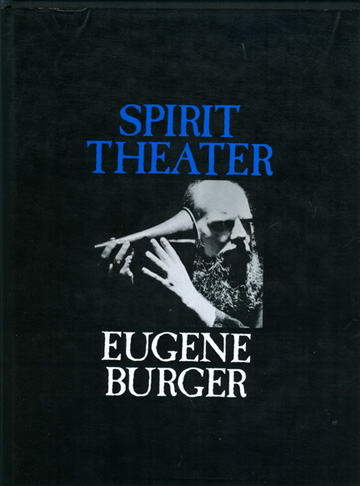 World's greatest spooky magic book. The lecture, a download from Penguin, is a fast 153-minute chat with host Dan Harlan, Eugene Burger, and Lawrence Hass. The viewer has the sense of sitting in on a conversation that is punctuated by occasional performance pieces. Among the highlights: Details of the Hauntings that inspired Spirit Theater, performed in a basement at Yale, at the University of Illinois in Champaign, in an attic in Evanston, and at the Lake Geneva Playboy Club. How to haunt a house. Discussion of a Ouija Board routine with a terrifying climax. Amazing Johnathon told me of a similar routine he had planned, to contact Grandma at a Halloween party. The Bell, Max Maven's Genii routine (August 2010) as perforned by Larry Hass. Dan had a cool suggestion for using the prop. Robert Neale's Soul Survivor, a creepy routine performed by Eugene, based on the PATEO force. There was a minor slipup in the execution that made the trick impossible, and yet it worked, fooling me badly! How Eugene used Micael Carbonaro as a spectator in a bizarre hypnosis stunt with an ending so eerie the team felt they had to explain it to the spectators. I'd have let them worry! The participants should film this for Michael's TV show. Demonstrations of the gadgets Eugene uses in the dark at his seances. Houdini might have featured this on stage. How to make ectoplasm. A discussion of The Lake Witch Project, my scream-inducing trick from The Little Egypt Book of Ghosts. Thanks, guys, for the nice words about the book and the trick. Eugene performing Edna St. Vincent Millay's "Ballad of the Harp Weaver," with a magic trick climax suggested by Jeff McBride. This was just as creepy to watch as I had always envisioned it. No better lead-in to a dark seance. 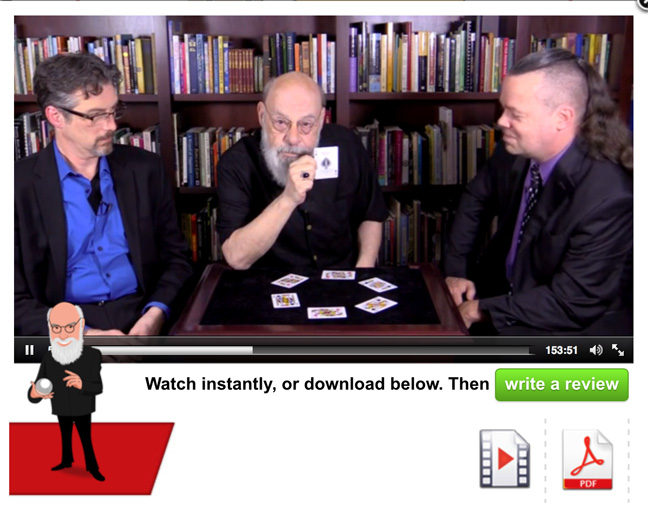 Eugene performs with Larry and Dan. I've been very happy with Penguin downloads, and this is no exception. Dan, Eugene, and Larry seemed to be having a great time. $29.95 from Penguin, immediately available. Spooky!
 Month9Books cover release. |
|
Congratulations to Magic Castle award winners.
Halloween is coming sooner than you think. Encounter it in Lucas Mackenzie and The London Midnight Ghost Show.
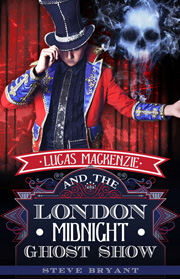
Little Egypt Magic is the erratically updated web site of Steve Bryant, spawned (the site, not Steve) by a former internet magazine known as The Little Egypt Gazette/for magicians only. Steve Bryant is an obscure magician and writer who generates this site from an iMac in Bloomington, Indiana. He used to frequently journey to and perform magic in Little Egypt, the local name for extreme southern Illinois, where the towns bear such names as Cairo, Thebes, and Karnak. Past issues of this web site: Index to Past Issues Notice: Any limited use of copyrighted images or quoted text is considered fair use, usually to review whatever product or event that is under discussion. If you object to use of any material, please get in touch and it will be cheerfully removed. |
A JSB Creations product
Copyright© 2016 by Steve Bryant